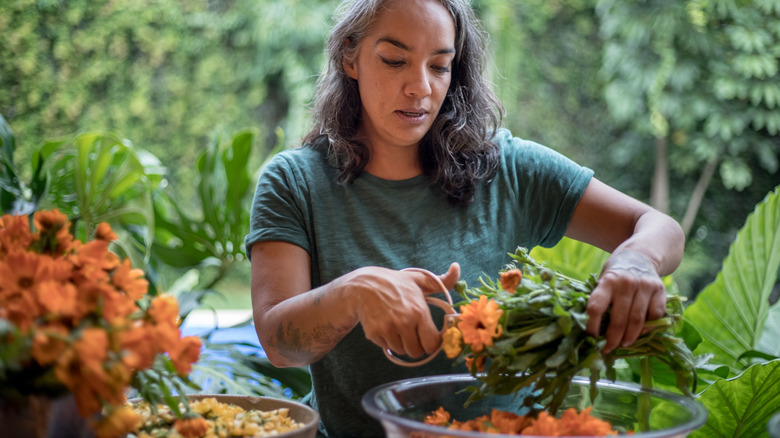Marigold Dyeing Is The Creative DIY You Won't Want To Miss This Season
There are several benefits to planting marigolds in your garden, including using the crowns to make a natural dye. The steeped flowers create a stain with varied hints of yellow, orange, and brown that can transform your white fabrics. You can make DIY tie dye bed sheets, curtains, tablecloths, and more. It is a great way to use fresh or dried flowers and even give new life to deadheaded blooms.
This marigold dye works best to color natural fabrics like cotton, wool, and silk. Synthetic fibers just don't absorb natural dyes as well, sorry polyester. While this dye process is simple, it does have a few important steps. For the best results, the fabric needs to be scoured and mordanted before marigolds enter the equation. Scouring the fabric removes dirt, dust, and grease from the fibers. The process is a little more intense than simply laundering the cloth in the washing machine. Mordanting is a wash with mineral salt (aluminum acetate or aluminum potassium sulfate) that prepares the fabric for dye, which helps the stain bond to the fibers. After those steps, it's time to have fun with the marigolds.
How to dye fabrics with marigolds
First, weigh your fabric while it's dry. This number is the weight of fabric (WOF) and is needed for each step of the process. Next, scour your fabric. You'll need 3% of the WOF in soap. You can use a pH neutral liquid dish soap or a detergent for wool. Fill a large pot with hot water and dissolve the soap in the water. Then, submerge the fabric and let it soak for an hour, stirring regularly. After, drain the water and rinse the cloth.
Next, mordant your fabric. For plant-based fabric like cotton or bamboo, use 10% of the WOF in aluminum acetate. Fill a pot with hot water and thoroughly dissolve the aluminum acetate. Let the fabric sit for four to 24 hours, stirring regularly. Then, rinse with cold water. For protein-based fabrics like wool or silk, use 10% of the WOF in aluminum potassium sulfate. Fill a pot with hot water and thoroughly dissolve the aluminum potassium sulfate. Submerge your fabric and let it simmer for two hours. Then, rinse with cold water.
Now, it's time to dye. The weight of marigolds should equal your WOF. Add the flowers to a pot of warm water and simmer. Steep the flowers for one hour before straining the liquid. Then, add your prepped fabrics to the pot. Heat the mixture on low for an hour, stirring occasionally. After, turn off the heat. You can take the fabric out now or steep it longer for a deeper hue. Let it dry, then wash the cloth on a gentle cycle with cold water and a pH neutral laundry detergent. Finally, enjoy your colorful fabric thanks to your natural garden dye.
